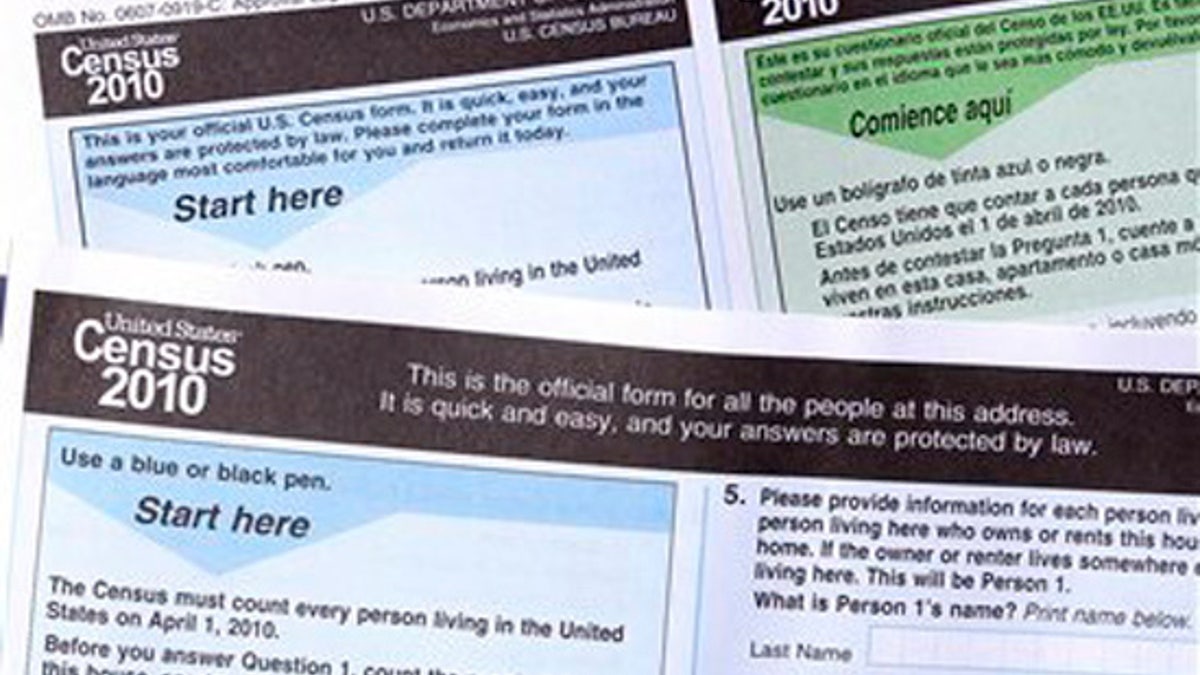
Copies of the 2010 Census forms are seen during a news conference Monday, March 15, 2010, in Phoenix to kickoff a national drive as Census forms are mailed to everyone. (AP)
The cost of the door-to-door count of the U.S. population is roughly doubling every 10 years even though the population isn't, according to a new Government Accountability Office report.
The 2010 census cost about $13 billion, up from the $8 billion price tag for the last national head count in 2000 and more than the initial cost estimate from 2001 of $11.3 billion.
During the same period, the U.S. grew to somewhere between 305.7 million and 312.7 million people, from 281.4 million, government estimates show.
That means the cost of doing the census soared by 62.5 percent while the population grew by less than 10 percent over the last 10 years.
The report, released this week, warns that if fundamental reforms aren't instituted, the cost of the next census could more than double.
"Indeed, the cost of conducting the census has, on average, doubled each decade since 1970, in constant 2010 dollars," the report said. "If that rate of cost escalation continues into 2020, the nation could be facing a $30 billion census."
The report comes just one week before the government releases the official 2010 census results that will be used to redistribute House seats.
The GAO found that problems with the agency's information technology system used to manage its responses to households that don't return census forms led to processing backlogs and prevented the bureau from implementing quality-assurance procedures as planned.
The agency this year tried for the first time to use handheld computers to verify addresses, follow up with households that didn't return questionnaires and perform other tasks. But certain "delete" operations malfunctioned, causing some major glitches. And after the successful completion of the address verification phase, the devices were phased out for any further use.
In the end though, the census came at least $1.6 billion under its $14.7 billion budget.
The GAO report said that refining current methods won't be enough to control costs.
"Further, our oversight of the 1990, 2000, and now 2010 Censuses suggests that the fundamental design of the enumeration – in many ways unchanged since 1970 – is no longer capable of delivering a cost-effective headcount given the nation's increasing diversity and other sociodemographic trends."
The Census Bureau blamed inflation and other factors for costs rising 40 percent per housing unit.
"However, the Census Bureau is on record that this is an unsustainable path," the agency said in a written statement. "Most of the increase is due to the ever rising labor and infrastructure expense to follow up with on some 45 to 50 million households that do not mail back a Census form."
"We are prepared to discuss with Congress innovations and alternative methods to meet the constitutional requirement to count everyone, which gets more difficult each decade as the population grows, becomes more diverse, and resides in more complicated housing situations."
A census oversight bill, which would have given the director more power and a longer term, cleared the Senate but failed in the House this month.
Some Republicans were concerned that the bill would have rewarded the agency for is repeated history of cost overruns and mishaps by giving the director more autonomy. They also said the bill didn't establish accountability – the agency wouldn't have been required to have an inspector general – or impose fiscal constraints.
"The census is a multi-billion dollar and very important endeavor. It's important the process be independent, while also holding its leadership accountable. This bill does not achieve that balance," said Rep. Patrick McHenry, the top Republican on the subcommittee overseeing the census.
"With the 2010 Census results being released next week, it is premature to consider this bill now – especially when we haven't had a single hearing on any provision in this bill."




